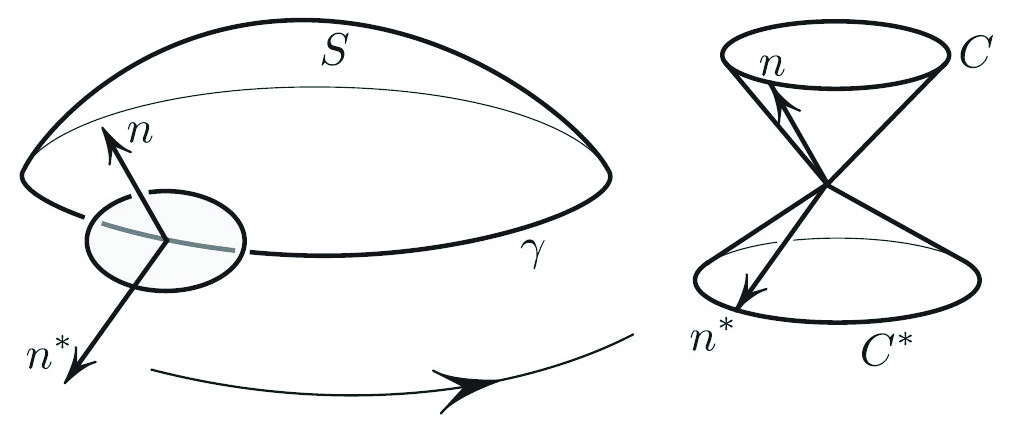A Bike Wheel and the Gauss-Bonnet Theorem
While fixing a punctured bike tire one day, I asked myself whether a wheel, held by the axle and having zero spin, can still turn around the axis. To be specific, let us make the axle describe a closed cone \(C\), coming back to its original position and keeping the center of the wheel fixed (the cone need not be circular). Despite the fact that the wheel never spins (the bearings are perfect) it ends up rotated, and through the angle that turns out (apologies for the pun) to equal the solid angle \(A(C)\) of the cone \(C\).
A geometric theorem about cones can explain this effect. As the wheel’s axis traces the cone \(C\) in Figures 1 and 2, the plane of the wheel remains tangential to another cone \(C^\ast\), the envelope of the family of planes normal to the generators of \(C\). In fact, the plane of the wheel rolls on \(C^\ast\) without sliding, as explained in Figure 2 (this kind of rolling is in complete contrast to the conventional way a wheel rolls on the ground). One can think of the two cones as a bouquet of right angle brackets, as in Figure 1. Speaking loosely, if one cone is sharp, the other is obtuse. The exact relationship between the cones turns out to be the following:
\[A(C)+L( C^\ast) = 2 \pi,\tag{1}\]
where \(L(C^\ast)\) denotes the length of the curve of intersection of the cone \(C^\ast\) with the unit sphere. A physical “proof” of this theorem, along with a rigorous proof, can be found in [1]. The physical “proof”—which led me to discover \((1)\) in the first place—uses imaginary springs and vacuum.

According to \((1)\), \(A(C)= 2 \pi - L(C^\ast)\); Figure 2 shows that the last expression is precisely the turning angle of the wheel, as claimed.
In fact, the “dual cones” theorem of \((1)\) implies a more general fact, the Gauss-Bonnet theorem – a generalization of the fact that the curvature \(k\) of a smooth, closed non-self-intersecting planar curve \(\gamma\) satisfies \(\int_{ \gamma} k\;ds= 2 \pi.\) According to this theorem (not stated here in its full generality), for a patch \(S\) of a smooth surface with a smooth boundary \(\gamma\) (see Figure 3), one has
\[ \int_{S} K\,dS+\int_{\gamma}k\,ds = 2 \pi, \tag{2}\]
where \(K\) is the Gaussian curvature and \(k\) is the geodesic curvature of \(\gamma\). According to \((2)\), the bulging of \(S\) decreases the total geodesic curvature of the boundary, speaking loosely (only the case \(K>0\) is discussed here).

The Gauss-Bonnet theorem boils down to the dual cones theorem \((1)\), as outlined in Figure 3. Starting with the surface patch \(S\), we construct the “porcupine” cone \(C\) of unit normal vectors \(n\) (the Gauss cone – Figure 3, right) and consider its dual cone \(C^*\). Intuitively, we can think of walking along \(\gamma\) and carrying a non-spinning wheel, keeping its axis (unit vector \(n\)) normal to \(S\). The wheel’s instantaneous angular velocity points along one of the spokes \(n^*\) (since the wheel is not spinning on its axis); these vectors transported to a common starting point form the dual cone \(C^*\) (see Figure 3, right). Now applying \((1)\) to these cones leads to the Gauss-Bonnet theorem \((2)\).

Indeed, \(\int_{S} K\,dS = A(C) \) by the definition of \(K\), and it only remains to explain why \(L(C^\ast)=\int_{\gamma}k\,ds\). Omitting the details, I will only mention that \(L(C^\ast)\) measures the angle by which \(n^*\) rotates in the tangent plane sliding along \(\gamma\), from the point of view of the observer walking around \(\gamma\). But \(n^*\) and \( \dot \gamma\) (the tangent to \(\gamma\)) rotate by the same amount, since the angle between them is unchanged after one traversal of \(\gamma\); the latter angle is \(\int_{ \gamma } k\,ds\) (by the definition of \(k\), which explains why \(\int_{ \gamma } k\, ds=L(C^\ast),\) and why \((2)\) indeed reduces to \((1)\).
The wheel provides us with a mechanical interpretation of parallel transport (each spoke undergoes parallel transport if the wheel does not spin on its axis). Further details on this can be found in [1], and the more standard treatments of the Gauss-Bonnet theorem in [2] and [3].
All figures are provided by the author.
Acknowledgments: The work from which these columns are drawn is partially supported by NSF grant DMS-9704554.
References
[1] Levi, M. (1994). A “bicycle wheel” proof of the Gauss-Bonnet theorem, dual cones and some mechanical manifestations of the Berry phase. Expo. Math, 12, 145-164.
[2] Pogorelov, A.V. (1959). Differential Geometry. (P. Noordhoff & N.V. Groningenm, Trans.) (pp. 160-161).
[3] Spivak, M. (1999). Chapter 6 in A Comprehensive Introduction to Differential Geometry. (Volume 3). (3rd ed.). Houston, TX: Publish or Perish, Inc.
About the Author
Mark Levi
Professor, Pennsylvania State University
Mark Levi (levi@math.psu.edu) is a professor of mathematics at the Pennsylvania State University.
Stay Up-to-Date with Email Alerts
Sign up for our monthly newsletter and emails about other topics of your choosing.



